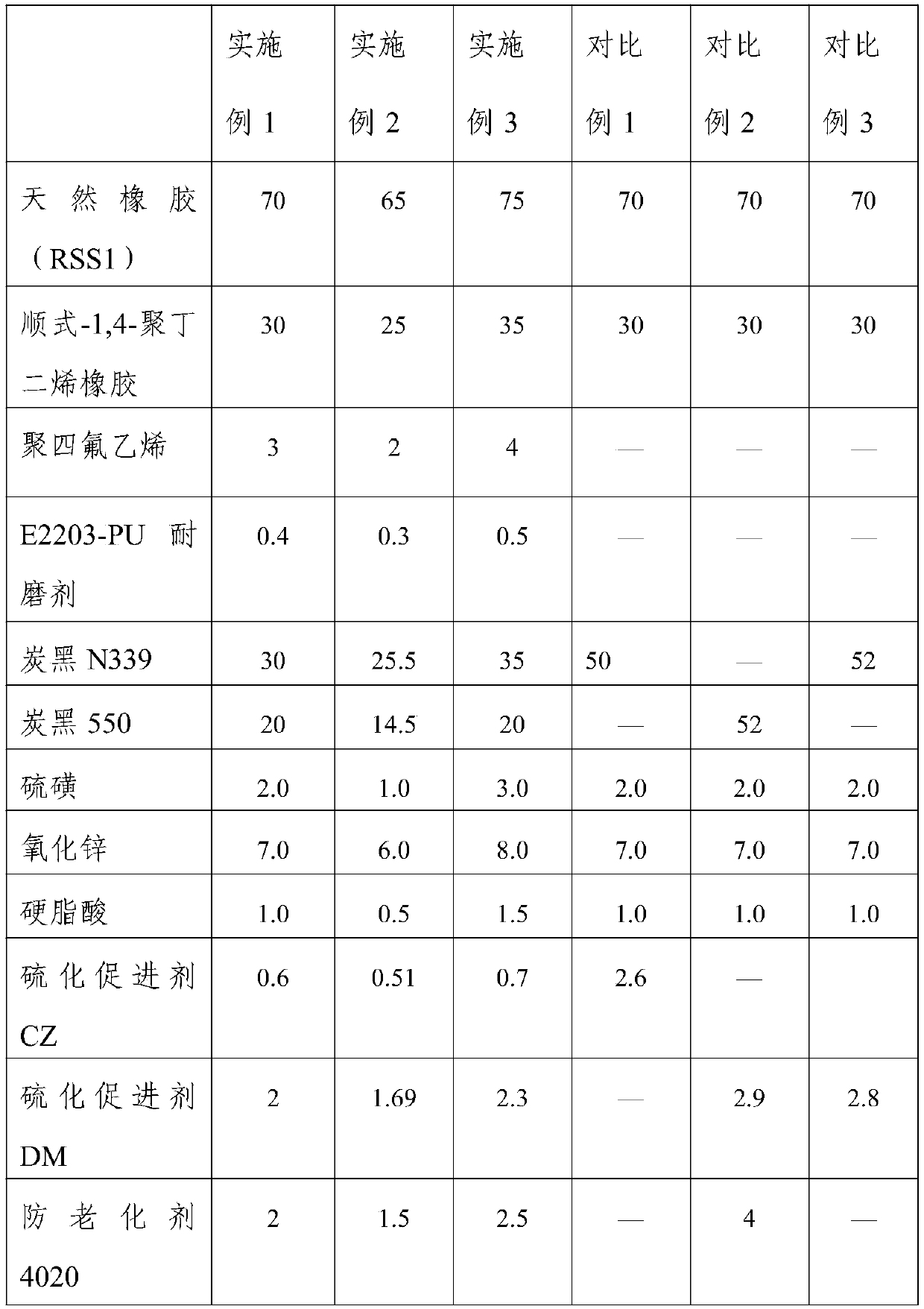Cut-resistant rubber lining
A technology of cutting resistance and lining plate, applied in the field of mill equipment, can solve the problem of low cutting resistance, achieve the same cutting resistance, prolong the vulcanization time, and improve the cutting resistance.
- Summary
- Abstract
- Description
- Claims
- Application Information
AI Technical Summary
Problems solved by technology
Method used
Image
Examples
preparation example Construction
[0049] Further preferred mode, the preparation method of above-mentioned rubber material, comprises the following steps:
[0050] S1: The natural rubber is masticated separately, the masticating time is 110-130s, and the masticating temperature is 130-150°C;
[0051] S2: Add cis-1,4-polybutadiene rubber, polytetrafluoroethylene and wear-resistant agent to the natural rubber that has been masticated in step: S1 to continue masticating. The above masticating time is 50-60s, The refining temperature is 70-90°C;
[0052] S3: Add carbon black, aromatic oil, anti-aging agent, zinc oxide, stearic acid and processing aids to the mixture completed in step S2 for mixing and debinding. The above mixing time is 180-220s. 140~160℃;
[0053] S4: Cool the mixture that has been mixed in step S3 to below 23°C, and park it for more than 24 hours, add sulfur and a vulcanization accelerator to continue the second mixing and debinding, the above mixing temperature is 90-100°C, and the mixing tim...
Embodiment 1~3
[0063] Embodiments 1 to 3: according to the rubber material formula specified in Table 1,
[0064] S1: the natural rubber RSS1 was masticated separately at 140°C for 120s;
[0065] S2: Add cis-1,4-polybutadiene rubber, polytetrafluoroethylene and E2203-PU wear-resistant agent to the natural rubber after masticating, and continue masticating for 60 seconds at a temperature of 80°C;
[0066] S3: Add carbon black, aromatic oil, anti-aging agent, zinc oxide, stearic acid and processing aids to the masticated mixture for mixing and debinding, the mixing time is 200s, and the mixing temperature is 150°C;
[0067] S4: The mixture after mixing is cooled to below 23°C and parked for more than 24 hours, adding sulfur and vulcanization accelerator to continue the second mixing and debinding, the mixing temperature is 95°C, and the mixing time is 180s;
[0068] S5: Put the mixture obtained by kneading into the mold cavity. Under the condition of 185KGF, control the vulcanization temperat...
Embodiment 4
[0077] Embodiment 4: according to the formula of the concrete rubber material of embodiment 1,
[0078] S1: masticate natural rubber RSS1 alone at 130°C for 110s;
[0079] S2: Add cis-1,4-polybutadiene rubber, polytetrafluoroethylene and E2203-PU wear-resistant agent to the natural rubber after masticating, and continue masticating for 50 seconds at a temperature of 70°C;
[0080] S3: Add carbon black, aromatic oil, anti-aging agent, zinc oxide, stearic acid and processing aids to the mixture that has been masticated to carry out mixing and debinding. The mixing time is 180s, and the mixing temperature is 140°C;
[0081] S4: The above-mentioned mixed mixture is cooled to below 23°C, and parked for more than 24h, adding sulfur and vulcanization accelerator to continue the second mixing and debinding, the mixing temperature is 90°C, and the mixing time is 170s;
[0082] S5: Put the mixture obtained by kneading into the mold cavity. Under the condition of 180KGF, control the vul...
PUM
 Login to View More
Login to View More Abstract
Description
Claims
Application Information
 Login to View More
Login to View More - R&D
- Intellectual Property
- Life Sciences
- Materials
- Tech Scout
- Unparalleled Data Quality
- Higher Quality Content
- 60% Fewer Hallucinations
Browse by: Latest US Patents, China's latest patents, Technical Efficacy Thesaurus, Application Domain, Technology Topic, Popular Technical Reports.
© 2025 PatSnap. All rights reserved.Legal|Privacy policy|Modern Slavery Act Transparency Statement|Sitemap|About US| Contact US: help@patsnap.com



